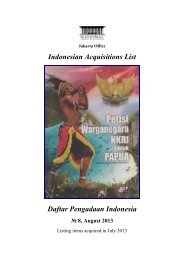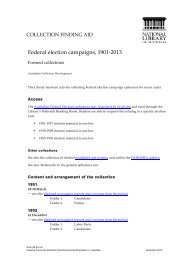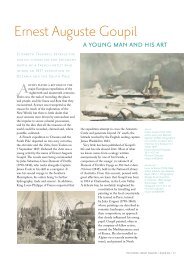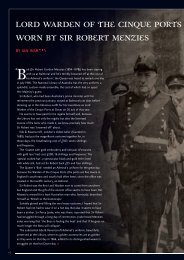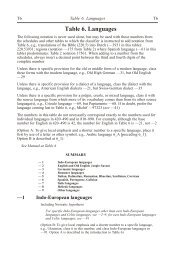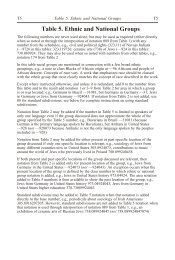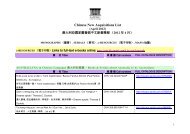Download the National Library Magazine - National Library of ...
Download the National Library Magazine - National Library of ...
Download the National Library Magazine - National Library of ...
You also want an ePaper? Increase the reach of your titles
YUMPU automatically turns print PDFs into web optimized ePapers that Google loves.
dispatched to Australia from Britain and<br />
Ireland for <strong>the</strong>ir crimes, were sentenced to<br />
solitary confinement for fur<strong>the</strong>r <strong>of</strong>fences in<br />
<strong>the</strong> colonies—and structures were needed to<br />
accommodate <strong>the</strong>m. Perhaps it was cheaper<br />
to burrow into <strong>the</strong> ground; perhaps it was<br />
more terrifying. Cruel, in <strong>the</strong> extreme, that<br />
convict children at Point Puer, <strong>of</strong>f Port Arthur,<br />
were placed in underground cells to aid <strong>the</strong>ir<br />
reformation. It might have driven some <strong>of</strong><br />
<strong>the</strong>m mad. Reporting to Lieutenant Governor<br />
Franklin, Benjamin Horne, a convict<br />
supervisor, wrote in 1843:<br />
solitary confinement is a punishment<br />
which seems more severely felt when <strong>of</strong><br />
any duration, as <strong>the</strong> diet is merely bread<br />
and water and communication with<br />
<strong>the</strong>ir companions is as much as possible<br />
prevented.<br />
But to put boys underground seems so much<br />
more cruel and terrifying than ‘mere’ solitary<br />
confinement. Some <strong>of</strong> <strong>the</strong> boys might have had<br />
memories <strong>of</strong> a burial in a church graveyard in<br />
<strong>the</strong>ir villages back home, perhaps <strong>of</strong> a beloved<br />
grandparent or o<strong>the</strong>r family member. As a boy<br />
was being lowered to his underground cell, did<br />
he fear that he was being buried?<br />
Convicts commonly worked underground,<br />
too. In <strong>the</strong> first years <strong>of</strong> <strong>the</strong> colony, on<br />
Cockatoo Island in Sydney Harbour, <strong>the</strong>y<br />
quarried into <strong>the</strong> sandstone to build wheat<br />
silos to store <strong>the</strong> precious foodstuff and help<br />
to prevent <strong>the</strong> starvation <strong>of</strong> <strong>the</strong> settlement that<br />
threatened <strong>the</strong> early years <strong>of</strong> its existence. The<br />
discovery <strong>of</strong> coal in <strong>the</strong> Illawarra and near<br />
Newcastle in 1796 and 1797 ensured that some<br />
convicts would be employed underground.<br />
The penal colony was exporting some coal<br />
to India by 1799 and, after 1804, when <strong>the</strong><br />
mine at Newcastle was placed on a proper<br />
working footing, coalmining became one <strong>of</strong><br />
<strong>the</strong> colony’s most important industries. Henry<br />
Osborne, to become possibly <strong>the</strong> colony’s<br />
most wealthy citizen by <strong>the</strong> time <strong>of</strong> his death<br />
in 1859, had heavily invested in coalmines in<br />
<strong>the</strong> Illawarra and around Maitland. Convicts<br />
were <strong>the</strong> first miners, working in fearsome<br />
conditions. In 1820, Superintendent <strong>of</strong> Mines,<br />
Benjamin Grainger, reported to Commissioner<br />
J.T. Bigge, who was investigating <strong>the</strong> colony,<br />
that ‘when all hands were employed <strong>the</strong> mine<br />
[at Newcastle] could produce twenty tons <strong>of</strong><br />
coal per day’. He continued:<br />
above left<br />
Underground Cells, Point Puer<br />
1911–1915<br />
b&w photograph; 8.6 x 13.4 cm<br />
Pictures Collection<br />
nla.pic-an23794111<br />
above right<br />
Charles J. Page (b. 1946)<br />
Five Coal Miners Having Lunch,<br />
Moura, Queensland 1986<br />
b&w photograph; 23 x 34.4 cm<br />
Pictures Collection<br />
nla.pic-vn3580895<br />
below left<br />
Christian Pearson (b. 1974)<br />
Long Way Down 2009<br />
digital photograph<br />
Pictures Collection<br />
nla.pic-vn6151836<br />
this required eight miners to descend <strong>the</strong><br />
shaft by windlass or ladder, crawl one<br />
hundred yards to <strong>the</strong> coalface, and gouge out<br />
two and a half tons <strong>of</strong> coal a day. Nineteen<br />
o<strong>the</strong>r convicts bailed out water, supervised<br />
<strong>the</strong> work, wheeled <strong>the</strong> coal to <strong>the</strong> shaft in<br />
THE NATIONAL LIBRARY OF AUSTRALIA MAGAZINE :: DECEMBER 2013 :: 13



